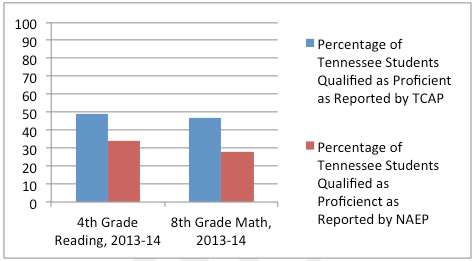Closing the “Honesty Gap” in Tennessee
Click here to see updated data for this state.
As with most states, discrepancies have emerged between student proficiency rates as reported by Tennessee state tests and the National Assessment of Educational Progress (NAEP), known as “the Nation’s Report Card.” For the 2013-14 school year, Tennessee showed a 15-point discrepancy between state reported proficiency scores and NAEP in fourth-grade reading, and a 19-point discrepancy in eighth-grade math. In Tennessee, the standard for proficiency and minimum score are set by the State Board of Education.
Tennessee K-12 Education at a Glance:
- K-12 Student Population: 993,496
- HS Graduation Rate: 86.3% 1
- College Enrollment: 62.1.0% 2
- College Remediation Rate: 71.2% in Two-Year Programs 3
Consequences of the Honesty Gap in Tennessee: Of the Tennessee students enrolled in four-year colleges that require remediation, only 44.4 percent complete a bachelor’s degree within six years. (4) Similarly, only 12.6 percent of students enrolled in community college that require remediation obtain a degree within three years. (5) Nationally, developmental education costs students and taxpayers about $7 billion each year. (6)
How Tennessee Closed the Honesty Gap: Tennessee adopted the Common Core State standards in 2010, which was quickly followed by extensive preparation for educators. They received intense professional development to deeply understand the differences in the standards and why they were necessary. Teachers slowly began integrating instruction to meet the new expectations in 2011-12 and by 2013 they was full implementation across the state. When Tennessee first adopted higher standards in 2008 (The Tennessee Diploma Project Standards), the Tennessee Comprehensive Assessment Program (TCAP) was adapted to better reflect the standards and higher, more appropriate cut scores were implemented. When students took the revised test for the first time in 2010, scores plummeted – reflecting the honest reality of student proficiency. But educators continued to persevere and perfect their instruction and students continued practicing the skills emphasized in the standards. Some teachers became “Core Coaches” and worked with their peers to create aligned lessons and materials. The results of this hard work were promising. Over the next few years, TCAP proficiency rates began to dramatically increase, by as much as 16 percentage points in math. Tennessee has become the model for the rationale for higher standards and aligned assessments to measure them. On the 2013 NAEP, scores in both subjects improved over 21 percentage points, making it the fastest improving state in the nation. Tennessee now has some of the smallest honesty gaps in the nation, with some grades and subjects having only an 8 percentage point gap.
Other States Leading the Way: More than half of all states demonstrated a 30-percentage point or more differential between their calculated proficiency rates and NAEP. Some states, such as Kentucky and Alabama took early steps to correct the Honesty Gap with promising results. Kentucky previously had some of the nation’s largest gaps, but after adopting a new, high-quality assessment, became one of the “Top Truth Tellers” in eighth-grade math, narrowing a 32-percentage point discrepancy to 15 between 2011 and 2014. Additionally, between 2012 and 2014, the number of eleventh-grade students meeting college-readiness benchmarks on the ACT college entrance test increased by 15 percentage points.
Alabama also had huge discrepancies between their state tests and NAEP. In 2014, less than half of Alabama’s students were on track to be ready for college in both subjects at almost every grade level. That year students began taking a new test, which dramatically narrowed the gap by 50 points in fourth-grade reading alone.
For more information read more: What is the Honesty Gap?
Back to Map

